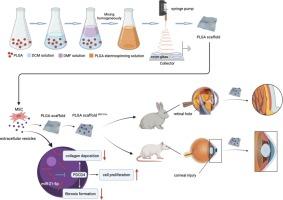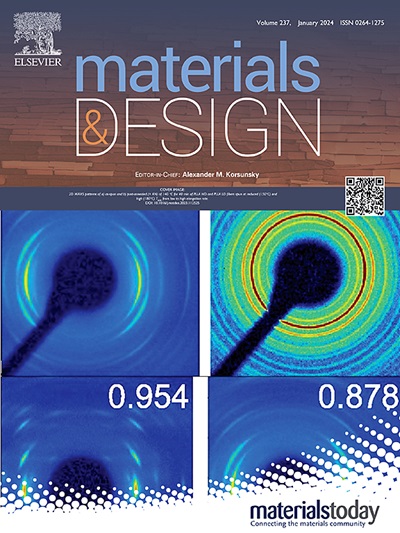Mesenchymal stem cells derived extracellular vesicles modified PLGA electrospinning nanofibrous scaffolds for corneal and retinal repair
IF 7.6
2区 材料科学
Q1 MATERIALS SCIENCE, MULTIDISCIPLINARY
引用次数: 0
Abstract
Tissue self-renewal is crucial for ocular diseases such as corneal damage and retinal holes. In this study, a novel Poly (lactic-co-glycolic acid) (PLGA) electrospinning nanofibrous scaffold (PLGAENS), loaded with mesenchymal stem cells-derived extracellular vesicles (MSC-EVs), was developed to accelerate the healing of the cornea and retina. In-vitro experiments confirmed the supportive properties of PLGAENS, demonstrating its ability to promote cellular proliferation, migration, and extension. In the rat corneal alkali burn model and rabbit retinal hole model, MSC-EVs modified PLGAENS (PLGAMSC-EVs) accelerated the restoration of the corneal epithelium and stroma, as well as the closure of retinal holes. Additionally, miR-21-5p was identified as being enriched in MSC-EVs. Mechanistically, miR-21-5p suppressed scar formation by targeting the programmed cell death protein 4 (PDCD4) gene, reducing fibrosis and the expression of collagen-related genes, which helped maintain corneal transparency and retinal integrity. Overall, these findings underscored the potential of PLGAMSC-EVs in promoting ocular wound healing and suggested a promising new therapeutic strategy for the clinical treatment of corneal damage and retinal holes.

用于角膜和视网膜修复的间充质干细胞衍生细胞外囊泡修饰聚乳酸(PLGA)电纺纳米纤维支架
组织自我更新对角膜损伤和视网膜孔等眼部疾病至关重要。本研究开发了一种新型聚(乳酸-共聚乙醇酸)(PLGA)电纺纳米纤维支架(PLGAENS),其中装载了间充质干细胞衍生的细胞外囊泡(MSC-EVs),以加速角膜和视网膜的愈合。体外实验证实了PLGAENS的支持特性,证明了其促进细胞增殖、迁移和延伸的能力。在大鼠角膜碱烧伤模型和兔视网膜孔模型中,间充质干细胞-EVs修饰的PLGAENS(PLGAMSC-EVs)加速了角膜上皮和基质的恢复,以及视网膜孔的闭合。此外,miR-21-5p 在间充质干细胞-EVs 中富集。从机理上讲,miR-21-5p 通过靶向程序性细胞死亡蛋白 4 (PDCD4) 基因抑制了疤痕的形成,减少了纤维化和胶原蛋白相关基因的表达,从而有助于保持角膜的透明度和视网膜的完整性。总之,这些发现强调了PLGAMSC-EVs在促进眼部伤口愈合方面的潜力,并为临床治疗角膜损伤和视网膜破洞提出了一种前景广阔的新治疗策略。
本文章由计算机程序翻译,如有差异,请以英文原文为准。
求助全文
约1分钟内获得全文
求助全文
来源期刊

Materials & Design
Engineering-Mechanical Engineering
CiteScore
14.30
自引率
7.10%
发文量
1028
审稿时长
85 days
期刊介绍:
Materials and Design is a multi-disciplinary journal that publishes original research reports, review articles, and express communications. The journal focuses on studying the structure and properties of inorganic and organic materials, advancements in synthesis, processing, characterization, and testing, the design of materials and engineering systems, and their applications in technology. It aims to bring together various aspects of materials science, engineering, physics, and chemistry.
The journal explores themes ranging from materials to design and aims to reveal the connections between natural and artificial materials, as well as experiment and modeling. Manuscripts submitted to Materials and Design should contain elements of discovery and surprise, as they often contribute new insights into the architecture and function of matter.
 求助内容:
求助内容: 应助结果提醒方式:
应助结果提醒方式:


